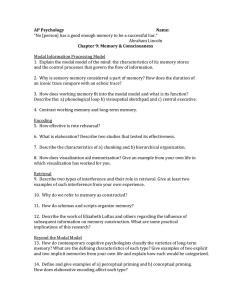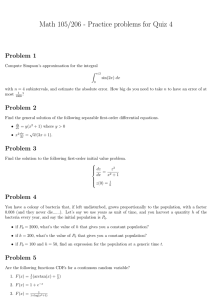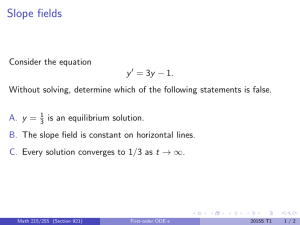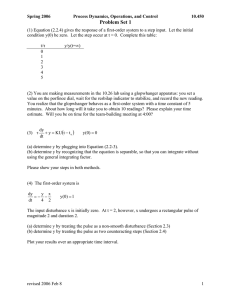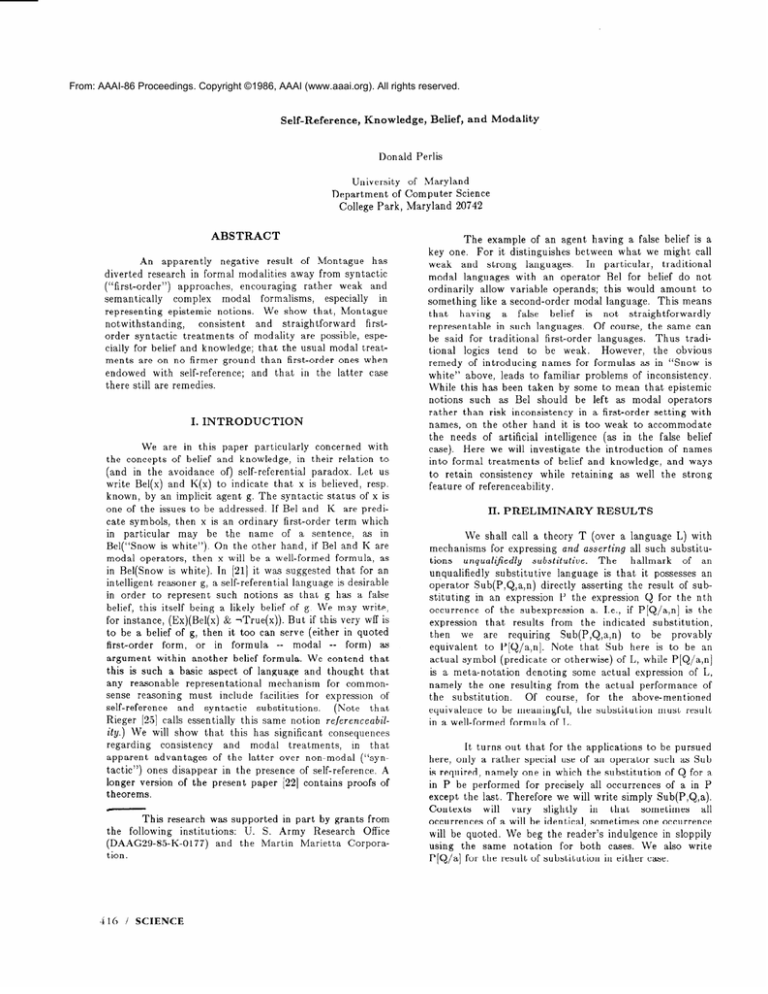
From: AAAI-86 Proceedings. Copyright ©1986, AAAI (www.aaai.org). All rights reserved.
Self-Reference,
Knowledge,
Donald
Belief,
and Modality
Perlis
University
of Maryland
Department
of Computer
Science
College Park, Maryland
20742
ABSTRACT
An apparently
negative
result
of Montague
has
diverted
research
in formal modalities
away from syntactic
(“first-order”)
approaches,
encouraging
rather
weak
and
semantically
complex
modal
formalisms,
especially
in
representing
epistemic
notions.
We show that, Montague
consistent
and
straightforward
firstnotwithstanding,
order syntactic
treatments
of modality
are possible,
especially for belief and knowledge;
that the usual modal treatments are on no firmer ground
than first-order
ones when
endowed
with self-reference;
and that
in the latter
case
there still are remedies.
I. INTRODUCTION
We are in this paper
particularly
concerned
with
the concepts
of belief and knowledge,
in their relation
to
(and in the avoidance
of) self-referential
paradox.
Let us
write Bel(x) and K(x) to indicate
that x is believed,
resp.
known,
by an implicit
agent g. The syntactic
status
of x is
one of the issues to be addressed.
If Be1 and K are predicate symbols,
then x is an ordinary
first-order
term which
in particular
may
be the name
of a sentence,
as in
Bel(“Snow
is white”).
On the other hand, if Be1 and K are
modal operators,
then x will be a well-formed
formula,
as
in Bel(Snow
is white).
In [al] it was suggested
that for an
intelligent
reasoner
g, a self-referential
language
is desirable
in order
to represent
such notions
as that g has a false
belief, this itself being a likely belief of g. We may write,
for instance,
(Ex)(Bel(x)
& -True(x)).
But if this very wff is
to be a belief of g, then it too can serve (either in quoted
first-order
form,
or in formula
-- modal
-- form)
as
argument
within
another
belief formula.
We contend
that
this is such a basic aspect
of language
and thought
that
any reasonable
representational
mechanism
for commonsense reasoning
must
include
facilities
for expression
of
(Note
that
self-reference
and
syntactic
substitutions.
Rieger
[25] calls essentially
this same notion
referenceability.) We will show that
this has significant
consequences
regarding
consistency
and
modal
treatments,
in that
apparent
advantages
of the latter
over non-modal
(“syntactic”)
ones disappear
in the presence
of self-reference.
A
longer version
of the present
paper
[22] contains
proofs of
theorems.
.
This research
was supported
in part by grants from
the following
institutions:
U. S. Army
Research
Office
and the Martin
Marietta
Corpora(DAAG29-85-K-0177)
tion.
416
/ SCIENCE
The example
of an agent having
a false belief is a
key one.
For it distinguishes
between
what we might call
In particular,
traditional
weak
and
strong
languages.
modal
languages
with an operator
Be1 for belief do not
ordinarily
allow variable
operands;
this would amount
to
something
like a second-order
modal language.
This means
a false
belief
is not
straightforwardly
that
having
representable
in such languages.
Of course,
the same can
be said for traditional
first-order
languages.
Thus
traditional
logics
tend
to be weak.
However,
the obvious
remedy
of introducing
names for formulas
as in “Snow is
white”
above,
leads to familiar
problems
of inconsistency.
While this has been taken by some to mean that epistemic
notions
such
as Be1 should
be left as modal
operators
rather
than risk inconsistency
in a first-order
setting
with
names,
on the other hand it is too weak to accommodate
the needs of artificial
intelligence
(as in the false belief
case).
Here we will investigate
the introduction
of names
into formal
treatments
of belief and knowledge,
and ways
to retain
consistency
while retaining
as well the strong
feature
of referenceability.
II. PRELIMINARY
RESULTS
We shall call a theory
T (over a language
L) with
mechanisms
for expressing
and asserting
all such substituhallmark
of an
tions
unqualifiedly
substitutive.
The
unqualifiedly
substitutive
language
is that it possesses
an
operator
Sub(P,Q,a,n)
directly
asserting
the result of substituting
in an expression
P the expression
Q for the nth
occurrence
of the subexpression
a. I.e., if P[Q/a,n]
is the
expression
that
results
from
the indicated
substitution,
Sub(P,Q,a,n)
to be provably
then
we are
requiring
equivalent
to P[Q/a)n].
Note that
Sub here is to be an
actual symbol
(predica.te
or otherwise)
of L, while P[Q/a,n]
is a meta-notation
denoting
some actual
expression
of L,
namely
the one resulting
from the actual
performance
of
Of course,
for the
above-mentioned
the
substitution.
equivalence
to be meaningful,
the substitution
must result
in a well-formed
formula
of L.
It turns out that for the applications
to be pursued
here, only a rather
special use of an operator
such as Sub
is required,
namely one in which the substitution
of Q for a
in P be performed
for precisely
all occurrences
of a in P
except the last. Therefore
we will write simply Sub(P,Q,a).
Contexts
will
vary
slightly
in
that
sometimes
all
occurrences
of a will be identical,
sometimes
one occurrence
will be quoted.
We beg the reader’s
indulgence
in sloppily
using
the same
notation
for both
cases.
We also write
P[Q/a]
for the result of substitution
in either case.
As will be seen, the asserting
of the results of sub&tutions,
i.e., relating
the referenced
syntactic
elements
to
their
intended
meanings,
runs
into
paradoxes
of selfreference.
Firstly,
a means of unquoting
quoted elements
is
needed; i.e., of saying formally
that “A” carries the meaning A. This is often represented
as defining
a truth
predicate: True(“A”)
is to tell us that the sentence
“A” carries
a true meaning,
i.e., A. That is, Sub(P,Q,a)
can be thought
of as consisting
of two conceptually
distinct
aspects:
forming the new expression,
and asserting
it. These we can conveniently
distinguish
by writing,
as a gloss for Sub(P,Q,a),
the (perhaps
pseudo-)
formula
True(sub(P,Q,a))
where sub
is a function
producing
(a name for) the expression
that
the indicated
substitution
leads to, and True asserts
this
expression.
Again of course this can be meaningful
only if
the substitution
leads to a wff of L.
corresponding
modal
treatments.
Unfortunately
he found
these versions
to be inconsistent,
whereas
each corresponding modal operator
version h1 is consistent.
This seemed to
be strong
evidence
in favor of the modal treat,ment.
However,
it
appears
that
the
inconsistency
Montague
uncovered
hinges
on
certain
fundamental
expressive
strengths
of quotational
first-order
languages
which
are
lacking
in usual modal languages.
That
is: first-order
logits have
richer
set,s of formulas
than
have
traditional
modal
logics. For variables
allow the formation
of (selfreferential)
wffs that otherwise
would not appear
in the
language,
and thus more is being asserted
in first-order
logic than in the corresponding
modal logic. The question
then arises:
if a modal
theory
M is made self-referential
[i.e., endowed
with expression
and assertion
of substitutions], is it, still consistent?
For
precision’s
sake
we
offer
the
following
definition:
Let T be a first-order
theory over a language
L
containing
a 3-place
predicate
symbol
Sub together
with
&“,a) cf P[Q/a]
where PiQ/a]
the axiom schema
Sub(“P”,”
is as previously
described,
for all wffs P and Q and terms a
of the language
I, (which is assumed
to contain
a constant
“A” for each wff A of L). Then
T is said to be an
unqualifiedly
substitutive
theory.
It is of separate
interest
whether
a first-order
logic
version of a modal logic can be kept suitably
“w-eak” so as
not to intrude,
via its variables,
new kinds of wffs that destroy a faithful
match
with the modal logic. This has been
explored
by [d es Rivieres
& Levesque
261. Our purposes
here are somewhat
different,
namely,
how to represent
propositional
attitudes
in an explicitly
self-referential
context.
Our contention
is that apart from a desire to avoid inconsistency,
there should be an underlying
intuitive
model justifying ones axioms,
and then presumably
whatever
underlying intuitive
model
justifies
the use of any particular
modal
formulation
should
apply
as well to the full firstorder formulation,
unless that model itself indicates
a principled argument
to the contrary.
Theorem
1: Let T be an unqualifiedly
order theory.
Then T is inconsistent.
For the proof
of this and
subsequent
substitutive
results,
see longer
first-
ver-
sion
In 1191 and [ZI] the difficulty
of formalizing
a truth
predicate
in first-order
languages
was circumvented,
based
on ideas in [Sj and [14j. It turns out t,hat. this approach
can be applied
fairly directly
as well to the Sub predicate,
and leads us to the following
result:
Theorem
2: A (“qualifiedly
substitutive”)
first-order
theory T formed from extending
a consistent
theory T’ not
involving
the symbol Sub, by the addition
of the (qualified)
schema
Sub(“P”,“Q”,a)
tf P[Q/a]*,
where o* is the result
of replacing
+ub(“P”,...)
by Sub(“lP”,...)
in CY, is consistent.
What we wish to investigate
eventually
(section IV)
is the extent
to which
the same result
holds for modal
theories.
First we turn to a question
addressed
by Montague 1161 concerning
first-order
ana!ogues
of certain
modal
theories.
III. FIRST-ORDER
ANALOGUES
There are some solid technical
benefits
that would
accrue
from a first-order
approach
to propositional
attiin the words of Montague
[16], “if
tudes;
in particular,
modal terms [i.e., modal operators]
become predicates,
they
will no longer give rise to non-extensional
contexts,
and the
customary
laws of predicate
calculus
may be employed.”
Motivated
by these concerns,
Montague
[16] applied
this
approach
to a modality
for necessity.
That is, writing
Net
(“A”) instead
of Net A he obtained
a quotational
firstorder construction.
Montague
proposed
axioms
for such a
formulation,
in analogy
with
standard
axioms
in the
Montague
studied
several
systems
related
to S5,
with the particular
aim of changing
Net int,o a predicate
symbol applied to names of formulas.
VVe need not present
details of these modal variants
in order to state the following variation
on a result of his, where we freely adopt the
symbol
I (for information)
in place of Net. (Note
that
under
an assumption
of omniscience,
S5 plausibly
formalizes the “information”
a reasoning
agent may have. VVe for
the moment
avoid the terms “knowledge”
and “belief”
in
favor of this more neutral
expression.)
If T is a first-order
theory
with function
symbols
sub and quote of three and one arguments,
respectively,
and supplied
wit#h a term ‘Lo” for each wff Q as well as
axioms defining
sub and quote appropriately,
i.e., quote(e)
ZZZZ“e” for each constant
symbol
e, and sub(P,Q,a)
=
i.e., the name of the result of the indicated
“<P[Q/a]>“,
substitution,
then T is first-order
self-referential.
Theorem 3: Let T be a first-order
self-referential
theory
having a monadic
predicate
symbol I and axioms I(“u.“) CY for each closed wff Q, and satisfying
the condition
]-l(“(sy”) whenever
)-- (u. Then T is inconsistent,.
\Yhat does this result
very weak subtheory
of S5,
order context,
goes awry, at
tutivity.
But is this reason
sion is better off? It is true
theories)
are consistent.
But
text. So the question
arises
such as S5 remain
consistent
tution capabilities.
KNOWLEDGE
tell us? It appears
that even a
when “translated”
into a firstleast in the presence
of substito think that the modal verthat S5 (and therefore
its subS5 is not in a substitutive
conas to whether
modal
theories
when augmented
with substi-
REPRESENTATION
/ t l-
IV.
SUBSTITUTrVE
MODAL
LOGIC
If we endow a modal logic M with the property
of
substitutivity
in the form of an operator
Sub(P,Q,a),
with
the intention
that
this thereby
create
suitable
conditions
for referenceability
within
such an extended
version
of M,
we have at least two available
approaches.
We can let P
and Q be quoted
expressions
and Sub a predicate
symbol,
or we can let P and Q be formulas
and Sub another
modality.
Let us begin
by exploring
the first
alternative.
Since we already
know that a first-order
unqualifiedly
substitutive
theory is inconsistent
(Theorem
l), then so will be
any modal theory M that extends such a first-order
theory.
Therefore,
if we endow S5 with a predicate
symbol
Sub,
we can’t
allow it the unqualified
substitution
axioms
as
well. What
then
if we use only
qualified
substitution
axioms of the sort known to be consistent
in the first-order
case? That
is, can we extend
S5 to include
Sub(x,y,z)
f-t
True(sub(x,y,z)
together
with the consistent
treatment
of
True and sub mentioned
earlier,
and thereby
retain
consistency
in the modal
theory
that results?
Unfortunately,
the following
result shows that we cannot.
Theorem
4: If M consists
of S5 extended
by the qualified
Sub predicate
with axiom Sub(x,y,z)
t-+ True(sub(x,y,z))
and associated
axioms for True and sub, then M is inconsistent.
We then consider
the second alternative
mentioned
above, namely,
that Sub(P,Q,a)
be a modality
in which P
and Q are formulas.
It turns out that even without
variarises.
contradiction
able
arguments
to
modalities,
Specifically,
we define T to be an unqualiJedly
substitutive
modal
logic if T has a modality
Sub(P,Q,a)
and the by
now familiar
substitution
axioms using P[Q/a],
where P, Q
and a are wffs. That
is, Sub(P,Q,a)
is equivalent
to the
result of substituting
Q for all but the last occurrence
of a
in P. (We need not even use names at all, for instead
of
arbitrary
expression,
it suffices to refer to whole formulas.)
Theorem 5: Any unqualifiedly
is inconsistent.
substitutive
modal
theory
So S5 itself is inconsistent
with either form of selfreference
that naturally
arises. We now turn to remedies of
this situation,
hinging
on separating
the two troublesome
features,
namely
the schema
I(“o?‘)-+cu,
and the rule for
inferring
I(“o?‘) f rom Q. This will at last split I into the
two cases of Be1 and K.
V. CONSISTENT
FORMALIZATIONS
We suggest
(as is fairly common)
that Kx means x
is among those beliefs of g that are true. It is important
to
emphasize
that K is to be a symbol in g’s own language,
so
that Kx means
to g that x is one of its true beliefs, even
though
in general
g cannot
identify
which these are! That
g can only
refer
in the abstract
to its
is, in general
knowledge
(true
beliefs).
Indeed,
all g’s beliefs
are (by
definition)
believed by g; as soon as any one is suspected
of
being false, it is no longer believed.
So g cannot
isolate its
true beliefs from the rest; it simply
can refer t#o them in
the abstract,
just as it can refer to its entire belief set. In
4 18
/ SCIENCE
effect, g may believe that (the extension
of K) is a proper
subset of (the extension
of) Bel, but can give no examples
! Thus general assertions
about
of the relative
complement
view of
K (such as that Kx + x) are part of g’s external
itself, so to speak, comparing
its belief set to an unauthenticated
outer world of truth,
while
assertions
about part,icular elements
are part of an internal
view of Be1 relevant.
to working
directly
with
individual
beliefs as things to use
in planning
and acting.
That
is, we are suggesting
two postulates,
one for
individual
beliefs
(from
x infer Be1 x), and one for the
totality
of beliefs and knowledge
((x)(Kx + x)). It is mixing the two that is problematic.
A judicious
approximat#ion
to a mix is however
possible,
as the following
results indicate.
Theorem 6: Let T be any consistent
qualifiedly
substitutive first-order
theory.
Then
there
is a consistent
firstorder theory
Int, which is an extension
of T having
predicate
symbol
Bel, and
obeying
the subsumed
rules
I-Bel(“cu”) iff I-- CY.
A still stronger
result
would
seem to arise if we
simply
formally
identify
Be1 with the predicate
Thm via
the use of Godel numbers.
This of course
requires
incorporating
a certain
amount
of number
theory
into
the
agent’s
reasoning,
but given the rather
powerful
assumptions that go into most logics of knowledge
(e.g., that all
logical
consequences
of an agent’s
knowledge
are also
known
to the agent),
this seems easy to grant.
hloreover,
the use of substitution
is virtually
tantamount
to the
introduction
of a certain
amount
of arithmetic
in any case
(see Quine
[24]), and we have argued
that substitution
is
an essential
feature
of commonsense
reasoning.
We then are left with the suggestion
that a theory
along the lines of Int is appropriate
for a formalization
of
belief. It allows for introspection,
to the extent that if a is
believed (affirmed)
then that very fact is also believed,
and
conversely.
But it makes
no claim
that
totality
of its
beliefs need be true, even though
each separate
belief is of
course asserted,
and hence taken to be the true. The strong
contrast
with a logic of knowledge
is shown in the following result,
which
is based
on [6,14,19,21].
Theorem 7: Let T be any consistent
qualifiedly
substitutive first-order
theory.
Then there is a consistent
first-order
theory
Ext, which
is an extension
of T having
predicate
symbol
K, and axioms
K(“cy”) --+ LY for each wff Q, and
obeying
the (subsumed)
rule that I-- K(“Q”)
whenever
I-of replacing
lK(“...“)
b?
where
CY* is the result
a*,
K(“l...“)
in 0.
From
cy can be inferred
Bel(L’o!“),
but
to infer
K(‘c~“) more is needed,
namely CY*, the positrive form of CL.
This can be interpreted
in various
ways depending
on the
underlying
conceptualization
of the formalism
either as the
agent’s-eye-view
of the world,
or as our own god’s_eye
more
fully
the
describes
view.
The
longer
paper
significance
of this and of the *; the latter
is the critical
distinction
between
K (Ext) and Be1 (Int). Note that for
most
wffs 0, CY* is a.
As with Int and belief, we suggest
Ext as a possibly
appropriate
formalization
of the notion
of an agent’s
knowledge.
But contradiction
will arise if the agent tries to
combine
Int and Ext into one theory
(i.e., with Be1 and K
conflated).
We hope to have suggested
why such a combination
is not appropriate.
More motivational
discussion
is
provided
in the longer paper. Elsewhere
[23] we have investigated
further
the ramifications
of the idea that an agent’s
beliefs are not all true (known),
and that a rational
agent
will believe that.
One more observation
is in order. An agent g may
reason
about
both its beliefs and its knowledge,
simply
by
combining
the theories
Int and Ext, but keeping K and Be1
as separate
predicates.
One can even relate
them judiciously, such as by the axiom Kx + Be1 x. This we state in
the following
theorem.
The extent
to which theories
such
as S5 can be viewed as ‘Lincorporated”
within theories such
as Omni below is discussed
in the longer paper.
Theorem
8:
Let
T
be
any
consistent
I would like to thank
highly
motivating
discussions
out the
elaboration
of the
Reiter,
Nils
Nilsson,
Jack
Michael
Miller,
Brian
Haugh,
and
Note that if we introduce
Kx by definition
to be
Bel(x) & True(x),
th en we can simply use axioms and rules
for True as in [21]. Th is then provides
a slightly
sharper
version
of Theorems
7 and 8, in which
for instance
K(“lK(“cr”)“)
may
be
inferred
from
[lBel(L’o”)
v
True(“lcr”)].
(1)
One can argue that although
an agent g can’t know
his beliefs to be true, still they might be true by good luck
(or by the clever design of the agent’s reasoning
devices by
a godlike
artificial
intelligencer),
and all g’s inference
rules
might be sound as well. But then, if g is an ideal reasoner,
wouldn’t
it. be appropriate
for g to believe
Be1 x -+ x? The
odd answer
(which
we have seen in Theorem
3) is: not if
g’s beliefs are to be consistent,
which of course they must
be if they are to be true. This can be seen also as an illicit
identification
of Be1 with K.
The proposed
theories
Int, Ext, and Omni appear
relevant
to the study
of omniscient
reasoning.
For limited
reasoning,
alterations
will be needed. Further
related
work,
especially
to the latter,
includes
[1,2,3,4,5,7,8,9,12,15,17,27].
Jim Reggia.
Drapkin,
J. and Perlis, D. Step-logics:
an alternative
approach
to limited reasoning. Proc. Eur. Conf. on Art.
Intell. 1986.
(2)
Drapkin,
J. and Perlis, D. A preliminary
excursion into
step-logics.
Proc. Intl. Symp. on Methodologies
for Intell.
Systems 1986.
(3)
Eberle, R. A logic of believing,
Synthese 26 (1974) pp.356-382.
(4)
Fagin, R., Halpern, J., and Vardi, M. A model-theoretic
analysis of knowledge. Proc. 25th IEEE Symp. on Foundations of Computer Science, 1984, pp.268-278.
(5)
Fagin, R. and Halpern,
J. Belief, awareness, and limited
reasoning: preliminary
report. IJCAI 85, pp.491-501.
(6)
Gilmore,
T. Jech
(7)
Halpern, J. and Moses, Y. Towards a theory of knowledge
and ignorance.
AAAI workshop on Nonmonotonic
Reasoning, 1984.
(8)
Halpern, J. and Moses, Y. A guide to the modal logics of
knowledge
and belief:
preliminary
draft.
IJCAI
85,
pp.480-490.
(9)
Hintikka,
J. Knowledge
Press, 1962.
(19)
Hughes G., and Cresswell,
logic. Methuen, 1968.
knowing
and
inferring.
P. The consistency
of partial set theory...,
in:
(ed.) A xiomatic Set Theory. Amer. Math. Sot.,
1974.
CONCLUSIONS
When
a formal
language
is endowed
with
selfreferential
capabilities,
especially
in the
presence
of
unqualifiedly
substitutive
mechanisms,
difficulties
of contradiction
can easily arise.
This holds for modal as well as
(pure)
first-order
logics.
However,
the features
of selfreference
and substitutivity
appear
fundamental
to any
broad
knowledge
representation
medium.
Moreover,
when
remedies
are taken,
the modal treatments
seems to offer no
advantage
over the first-order
ones, and indeed the latter
carry advantages
of their own.
the following
individuals
for
that prompted
me to carry
ideas presented
herein:
Ray
Minker,
Jennifer
Drapkin,
Kurt
Konolige,
Dana Nau,
REFERENCES
qualifiedly
substitutive
first-order
theory.
Then there is a consistent
first-order
theory Omni, which is an extension
of T having
predicate
symbols
Be1 and K, the axioms of Int and Ext as
in Theorems
6 and 7, and axiom Kx -+ Be1 x.
VI.
ACKNOWLEDGEMENTS
and
belief.
Cornell
University
M. An introduction
to modal
(11)
Israel, D. What’s wrong with nonmonotonic
logic? Proc.
First Annual National
Conference
on Artificial
Intelligence, 1980.
(12)
Konolige, K. A computational
tion. IJCAI 85, pp.503-508.
(13)
Kripke, S. Semantical analysis of modal logic. Zeitschrift
fur Mathematische
Logik und Grundlagen
der Mathematik, 9, (1963), pp.67-96.
(14)
Kripke,
S. Outline
(1975), pp.690-716.
(15)
Levesque, H. A logic
3rd National
Conf.
pp.198-202.
(16)
Montague, R. Syntactical treatments
Philos. Fenn. 16, (1963) pp.153-167.
(‘7)
Moore, R. Reasoning
77, pp.223-227.
(18)
Partee,
1976.
B.
(ed.)
of
theory
a theory
of belief
of
truth,
introspec-
J. Phil.,
72
of implicit and explicit belief. Proc
on Artificial
Intelligence,
1984,
of modalit,y....
Acta
and action.
IJCAI
Academic
Press,
about knowledge
Montague
KNOWLEDGE
grammars.
REPRESENTATION
/ i lc)
(19)
Perlis, D.
Language,
thesis. U of Rochester,
computation,
1981.
(20)
Perlis,
D. Nonmonotonicity
and real-time
AAAI Workshop on Nonmonotonic
Reasoning,
(21)
Perlis, D. Languages
AIJ 25, 1985.
(22)
Perlis, D. Languages
Report.
(23)
Perlis, D. On the consistency
U of Md Tech Report.
(24
Concatenation
Quine, W.
Symb. Logic, 11 (1946).
(25)
Rieger, C. Conceptu al memory...
University, 1974.
Ph.D.
thesis.
Vardi,
M. A model-theoretic
knowledge. IJCAI 85, pp.509-512.
analysis
of
with
and
self-reference
self-reference
reality.
Ph.D.
reasoning,
1984.
I: foundations.
II. U of Md Tech
of commonsense
reasoning.
as a basis for arithmetic.
J.
Stanford
(26)
(27)
420
/
SCIENCE
monotonic

